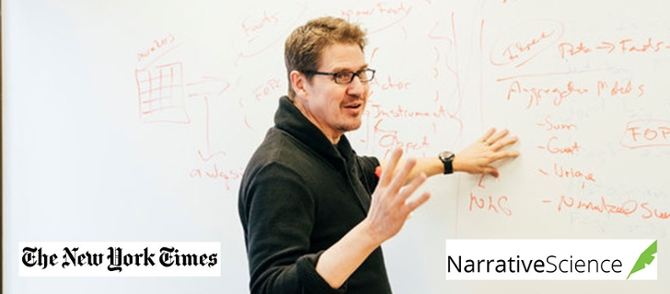NY Times Spotlights Hammond's Narrative Science
The field of artificial intelligence's reemergence is translating into strong business numbers.

Prof. Kristian Hammond of Narrative Science has been quoted in a recent New York Times article discussing his Chicago start-up company's software research advances in A.I. and how the fields reemergence is translating into strong business numbers.
Narrative Science is focused on creating exceptional software, starting with their advanced natural language generation platform, Quill, that transforms data into meaningful and insightful narratives people can simply read. Quill enables organizations to spend less time crunching numbers and more time providing their employees and customers with actionable information that, ultimately, makes them smarter.
Excerted from an Sunday, February 28, 2016 article published by The New York Times, titled, "Start-Up Lessons From the Once-Again Hot Field of A.I."
In 2010, Kris Hammond, an experienced artificial intelligence researcher, and a few partners founded Narrative Science. The Chicago start-up’s software ingests and interprets numbers for things like investment holdings, billing records and sports statistics and transforms them into written summaries or stories.
From the outset, the company’s technology was promising, but the timing was tricky. It opened its doors the year before IBM’s Watson publicly demonstrated the potential of machine intelligence with its “Jeopardy!” victory.
“At the start, we didn’t call it artificial intelligence because A.I. was still in disrepute,” recalled Mr. Hammond, chief scientist for Narrative Science.
Today, a start-up that can lay claim to doing artificial intelligence has increased its odds of getting attention and funding. A.I. efforts, scientists agree, are far more advanced than in past boom and bust cycles for this type of technology.
Yet if the technology seems almost magical at times, success, venture capitalists and entrepreneurs say, will rely on basic business virtues like focus, flexibility, speed and resilience.
That is particularly true for start-ups. “Big companies like Google can make A.I. investments with a 10-year horizon, but a start-up has to release a product in a year or two,” said Chris Dixon, a general partner at Andreessen Horowitz.
In past cycles, research advances in A.I. generated excitement but not much business. “It was a long, long way from being practical,” said Forest Baskett, a computer scientist and partner at New Enterprise Associates. “What makes it investable now is there are applications, things you can do with these tools.”
The technical ingredients behind modern A.I., he noted, were vast new sources of data, machine-learning software and powerful, inexpensive computing delivered over the so-called computing cloud.
When asked about investable applications in N.E.A.’s portfolio, Mr. Baskett pointed to three examples that exploit data and machine-learning: DataRobot, which evaluates math models to predict which will work best on a particular kind of data; Dato, whose machine-learning tools analyze the graphs of online users’ social connections; and Qbotix, which makes specialized robots for optimally tilting and maintaining the panels that absorb the sun’s rays on solar farms.
“Today, we can measure so much more,” Mr. Baskett said.
His comment underlines the fact that there is no bright line separating big data analytics and A.I. In both cases, data is the fuel and machine-learning algorithms are the engine of pattern recognition and classification. Yet A.I. technology, propelled by advances in so-called deep-learning techniques, is moving up the ladder of perception, becoming far better at mimicking the humanlike tasks of seeing and hearing — image recognition and speech recognition, in computing terms.
In 2014, after three years leading the drive to commercialize Watson at IBM, Manoj Saxena left and founded Cognitive Scale. The start-up, based in Austin, Tex., is focused on building applications on top of Watson. IBM is known for collaborating with large corporations on lengthy, costly projects — though it has embarked on a campaign to move faster and cater to a broader audience of customers.
Cognitive Scale concentrates on short sprints with small teams, getting a working application up and running within 90 days. Speed to market is its product. Cognitive Scale is working first with customers in the health care, finance and retailing industries.
“Our approach is small bets, brought to market quickly for better decisions and better customer engagement in your industry,” said Mr. Saxena, the chairman. “We bring practical A.I. into businesses.”
What the market wants has been the lesson learned at Narrative Science. Its founding team included professors from Northwestern University’s computer science and journalism departments.
It began by writing short but remarkably fluent and varied stories for customers like the website of the Big Ten athletic conference. In 2011, Mr. Hammond, a Northwestern professor, predicted in an interview that in five years, smart software would win a Pulitzer Prize, and he wanted it to be his company’s technology.
A Pulitzer Prize is still a worthy, if more distant, goal, Mr. Hammond said recently. But Narrative Science, which is growing briskly and has 80 employees, has built its business outside the financially challenged news media industry.
Its 70 customers are mainly in mainstream businesses like financial services and consulting, including Nuveen, USAA, Credit Suisse and Deloitte, which use the Narrative Science software to generate reports that explain the numbers in investment portfolios, trading records and market statistics.
